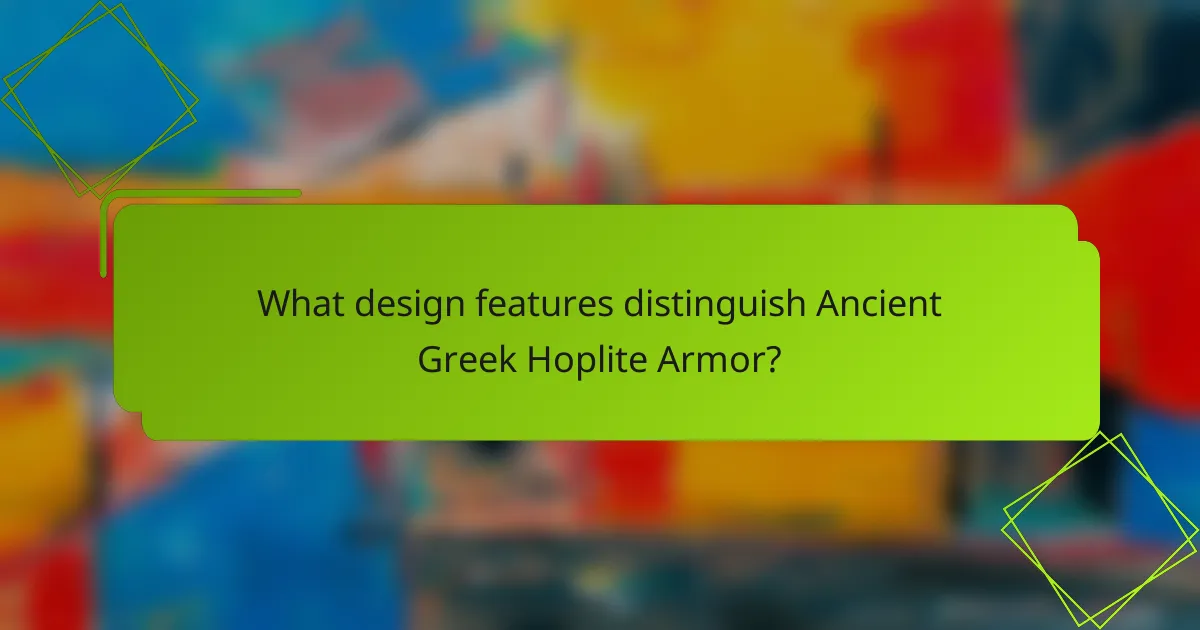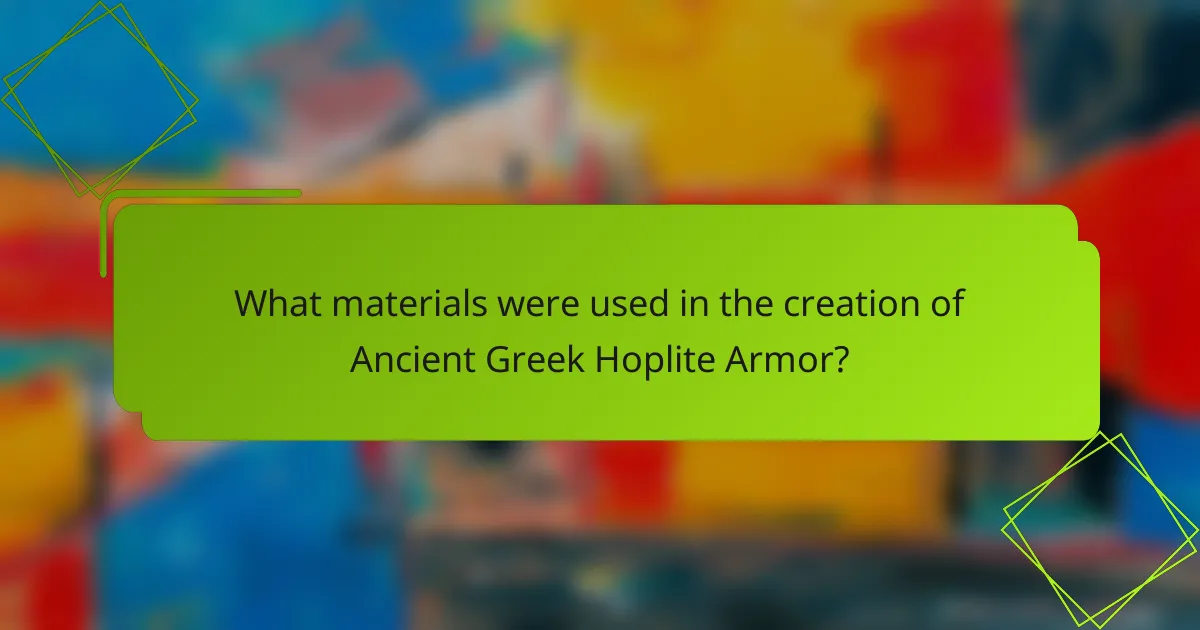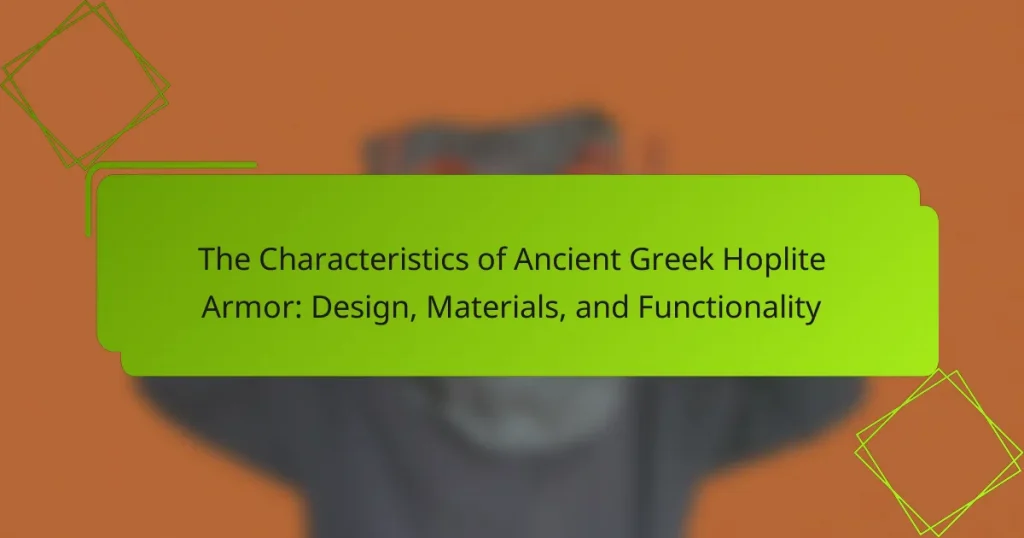Ancient Greek Hoplite Armor is a specialized military equipment used by citizen-soldiers known as hoplites. This armor typically consists of a bronze helmet, a cuirass for torso protection, greaves for the legs, and a large round shield called a hoplon. Key design features include the thorax breastplate, which safeguards vital organs, and the helmet, which may have cheek guards and a crest. Constructed primarily from bronze, leather, and linen, this armor emphasizes both protection and mobility, significantly enhancing the effectiveness of hoplites in battle, particularly during the phalanx formation. The article will explore the design, materials, and functionality of this critical military gear.

What is Ancient Greek Hoplite Armor?
Ancient Greek Hoplite armor is a type of military equipment used by hoplites, the citizen-soldiers of ancient Greece. This armor typically included a bronze helmet, a cuirass (body armor), greaves for leg protection, and a shield known as a hoplon. The bronze helmet protected the head and often featured a crest for identification. The cuirass was made of bronze or leather, covering the torso to safeguard vital organs. Greaves were worn on the shins to protect against attacks. The hoplon shield was large and round, providing defense and allowing for effective formation fighting. This armor was crucial for the effectiveness of hoplites in battle, particularly during the phalanx formation, which relied on the protection and coordination of soldiers.
How did Ancient Greek Hoplite Armor evolve over time?
Ancient Greek Hoplite armor evolved significantly from the 8th century BCE to the 4th century BCE. Initially, armor consisted of simple bronze breastplates and helmets. By the 7th century BCE, the development of the aspis shield and the bronze cuirass improved protection. The introduction of the linothorax, a lightweight linen armor, occurred in the 5th century BCE. This change allowed for greater mobility in battle. Additionally, decorative elements became more prevalent, reflecting individual identity and city-state affiliation. The evolution of armor was influenced by advancements in metallurgy and changes in combat tactics. Historical evidence shows that armor became more standardized as hoplite warfare became more organized.
What historical influences shaped the design of Hoplite Armor?
The design of Hoplite Armor was shaped by various historical influences including warfare practices and regional styles. The rise of the phalanx formation in ancient Greek warfare necessitated armor that provided both mobility and protection. This led to the development of the aspis, a large round shield that complemented the armor. Additionally, the influence of earlier bronze age armor designs can be seen in the use of bronze plates and linings. The socio-political landscape of city-states also impacted armor design, as wealthier states produced more elaborate and decorative armor. The evolution of military tactics throughout the 5th century BCE further refined armor specifications to enhance effectiveness in battle.
How did changes in warfare impact armor development?
Changes in warfare significantly influenced armor development. As battle tactics evolved, so did the need for more effective protective gear. The introduction of phalanx formations required armor that allowed for greater mobility and protection. Consequently, hoplite armor became more streamlined and efficient. Innovations included the use of bronze for its durability and the design of the aspis shield for enhanced defense. Historical records show that these advancements were crucial during conflicts like the Persian Wars. The changing dynamics of warfare necessitated constant adaptations in armor design to meet new challenges on the battlefield.
What are the key components of Ancient Greek Hoplite Armor?
The key components of Ancient Greek Hoplite Armor include the helmet, breastplate, greaves, and shield. The helmet, often made of bronze, protected the head and face. The breastplate, known as the cuirass, shielded the torso and was typically crafted from bronze or leather. Greaves were worn on the shins to guard the legs. The shield, called the aspis or hoplon, was large and round, providing crucial defense. These components worked together to offer comprehensive protection in battle, reflecting the military needs of the hoplite soldiers in ancient Greece.
What materials were commonly used in the construction of Hoplite Armor?
Hoplite armor was commonly constructed using bronze and leather. Bronze served as the primary material for helmets, breastplates, and greaves. It provided durability and protection against weapons. Leather was often used for the padding and straps, offering comfort and flexibility. Some hoplites also incorporated linen or wool for additional layers. Historical evidence indicates that bronze was favored for its strength in combat situations. The combination of these materials ensured a balance between mobility and defense for the hoplites.
How did the design of the armor contribute to a hoplite’s protection?
The design of hoplite armor significantly enhanced a soldier’s protection. The armor typically included a bronze breastplate, which provided a strong defense against enemy weapons. Its shape was contoured to fit the body, allowing for mobility while covering vital areas. Additionally, the greaves protected the lower legs, preventing injury from strikes. The helmet featured a thick metal construction that shielded the head and face. This combination of elements created a comprehensive protective system. Historical accounts indicate that hoplites were more resilient in battle due to their armor design. The use of layered materials further increased durability and resistance to [censured]. Overall, the thoughtful design of hoplite armor was crucial for their battlefield effectiveness.
What were the primary functions of Ancient Greek Hoplite Armor?
The primary functions of Ancient Greek Hoplite Armor were protection, mobility, and intimidation. The armor was designed to shield the wearer from enemy weapons. It typically included a bronze breastplate, greaves, and a helmet. These components provided substantial defense against slashing and piercing attacks. The armor also allowed for relative mobility on the battlefield. This balance was essential for the phalanx formation used by hoplites. Additionally, the armor served to intimidate opponents with its imposing appearance. The visual impact of the armor could affect the morale of enemy troops.
How did Hoplite Armor enhance the effectiveness of Greek soldiers in battle?
Hoplite armor enhanced the effectiveness of Greek soldiers in battle by providing superior protection and mobility. The armor typically consisted of a bronze breastplate, greaves, and a helmet. This design safeguarded vital areas, reducing injuries from enemy weapons. The weight of the armor was balanced to allow for agility during combat. Additionally, the shield, known as the hoplon, was large and round, offering excellent defense while enabling offensive maneuvers. Historical battles, such as those at Marathon and Thermopylae, demonstrated the effectiveness of hoplite formations, where soldiers fought cohesively. The combination of protection and tactical formation increased the overall combat effectiveness of Greek hoplites.
What role did armor play in the tactics employed by hoplites?
Armor played a crucial role in the tactics employed by hoplites. The armor provided protection during close combat, allowing hoplites to engage effectively in phalanx formations. The heavy bronze breastplate, greaves, and helmets shielded vital areas from enemy weapons. This protection enabled hoplites to maintain their positions and advance against opponents. The weight of the armor also influenced their tactics, requiring disciplined formations and coordinated movements. Historical accounts, such as those from Thucydides, highlight the importance of armor in ensuring the survival of soldiers in battle. Additionally, the hoplite’s armor was designed to enhance mobility while offering substantial defense. This balance of protection and maneuverability was key to their battlefield effectiveness.

What design features distinguish Ancient Greek Hoplite Armor?
Ancient Greek Hoplite Armor is distinguished by several key design features. The armor typically includes a bronze breastplate known as a thorax. This breastplate provides essential protection to the torso. Hoplites also wore a helmet, often crafted from bronze, which protected the head and face. The design of the helmet varied, with some featuring cheek guards and a crest.
Another notable feature is the greaves, which are shin guards made of bronze or leather. These protect the lower legs during combat. The armor often included a large round shield called a hoplon. This shield was crucial for defense and was carried on the left arm.
Hoplite armor also emphasized mobility and flexibility. The materials used, such as bronze, allowed for both protection and ease of movement. These design elements collectively contributed to the effectiveness of the hoplite in battle.
How did the shape and fit of Hoplite Armor affect its functionality?
The shape and fit of Hoplite Armor significantly influenced its functionality. The armor was designed to conform closely to the body. This close fit allowed for greater mobility during combat. It minimized excess weight and bulk, which could hinder movement. The shape of the armor also provided effective coverage of vital areas. It protected the torso while allowing for arm and leg movement. Additionally, the design facilitated the use of a shield, enhancing defensive capabilities. Historical evidence shows that this combination of shape and fit was crucial in the phalanx formation, where coordination and mobility were essential for success in battle.
What specific design elements contributed to mobility and protection?
The specific design elements that contributed to mobility and protection in Ancient Greek hoplite armor include the lightweight construction, articulated joints, and strategic padding. The armor was often made from bronze or leather, which provided adequate protection without excessive weight. Articulated joints allowed for greater freedom of movement during battle. The design featured a broad, conical helmet that protected the head while not obstructing vision. Additionally, the use of a smaller shield enabled hoplites to maneuver effectively. Research indicates that these elements allowed hoplites to engage in both offensive and defensive tactics efficiently, balancing protection with the need for movement in combat scenarios.
How did armor fit vary among different hoplite classes?
Armor fit among different hoplite classes varied significantly based on social status and wealth. Wealthier hoplites, known as “armored citizens,” had access to custom-fitted armor. This armor offered better mobility and protection. In contrast, lower-class hoplites often wore standardized, ill-fitting armor. This resulted in reduced effectiveness in battle. Historical records indicate that the quality of armor influenced combat performance. The disparity in armor fit reflected broader social hierarchies in ancient Greece.
What decorative aspects were present in Ancient Greek Hoplite Armor?
Ancient Greek Hoplite armor featured several decorative aspects. These included intricate designs and motifs engraved or painted on the armor. Common decorations were geometric patterns, floral designs, and depictions of mythological scenes. The use of bright colors enhanced the visual appeal of the armor. Additionally, some helmets had plume attachments for further ornamentation. Shields often displayed personalized emblems or symbols, showcasing individual identity. These decorative elements served both aesthetic and symbolic purposes. They reflected the warrior’s status and pride in their heritage.
How did ornamentation reflect the identity of the hoplite?
Ornamentation reflected the identity of the hoplite by showcasing their social status, personal valor, and regional affiliations. Hoplites often adorned their armor and shields with symbols, motifs, and colors unique to their city-state. These decorations served as identifiers, distinguishing them from soldiers of other regions. For example, the use of specific emblems, like the owl for Athens, indicated loyalty and pride in one’s city. Additionally, intricate designs and embellishments could signify an individual’s wealth and noble lineage. The more ornate the armor, the higher the perceived status of the hoplite. These visual cues communicated not only personal identity but also collective identity within the context of warfare. The ornamentation thus played a crucial role in both individual and group representation on the battlefield.
What symbols or motifs were commonly used in armor decoration?
Common symbols and motifs used in armor decoration included animals, deities, and geometric patterns. Animals such as lions and eagles symbolized strength and courage. Deities like Athena represented protection and wisdom. Geometric patterns often conveyed status and artistry. These motifs were not only decorative but also held cultural significance. Historical artifacts show these designs were prevalent in ancient Greek armor. For example, the Corinthian helmet featured intricate engravings of mythological scenes. Such decorations served to inspire fear in enemies and pride in the wearer.

What materials were used in the creation of Ancient Greek Hoplite Armor?
Ancient Greek Hoplite Armor was primarily made from bronze, leather, and linen. Bronze was used for helmets, breastplates, and greaves due to its strength and durability. Leather was commonly utilized for straps and padding. Linen was often layered to create lighter armor, known as linothorax. These materials provided a balance between protection and mobility for the hoplites. Historical evidence shows that bronze armor became prevalent in the 7th century BCE. The use of these materials contributed to the effectiveness of hoplites in battle.
What types of metal were utilized in Hoplite Armor construction?
Hoplite armor was primarily constructed using bronze and iron. Bronze was favored for its durability and resistance to corrosion. This metal was commonly used for helmets, breastplates, and greaves. Iron became more prevalent later, especially for weapons and some armor components. The transition to iron allowed for stronger and more affordable armor. Historical evidence shows that bronze armor was prevalent during the Classical period, while iron emerged in the Hellenistic era.
How did the choice of materials influence the weight and durability of the armor?
The choice of materials significantly influenced the weight and durability of ancient Greek hoplite armor. Lighter materials like bronze reduced the overall weight, allowing for greater mobility. Heavier materials, such as iron, increased durability but added weight. The balance between these materials determined the armor’s effectiveness in battle. For instance, bronze armor was favored for its strength and resistance to corrosion. Iron, while durable, was prone to rust if not maintained. Historical evidence shows that hoplites preferred bronze for its optimal combination of weight and durability. This choice directly impacted their combat performance and endurance on the battlefield.
What non-metal materials complemented Hoplite Armor?
Hoplite Armor was complemented by non-metal materials such as leather and linen. Leather was used for straps and protective elements due to its flexibility and durability. Linen served as a lightweight undergarment, providing comfort and additional protection. These materials were essential for mobility and ease of wear. Historical evidence shows that ancient Greek hoplites utilized these materials to enhance their armor’s effectiveness. The combination of metal and non-metal materials contributed to the overall functionality of Hoplite Armor in battle.
How did leather and fabric enhance the functionality of the armor?
Leather and fabric enhanced the functionality of armor by providing flexibility and comfort. Leather was used for its durability and ability to absorb shock. It allowed for better movement compared to rigid metal plates. Fabric, often used as padding, improved overall comfort for the wearer. It also helped in reducing chafing during combat. Together, these materials contributed to a balance between protection and mobility. Historical evidence shows that hoplite armor often incorporated these elements for practical use in battle. The combination allowed soldiers to maintain agility while being adequately protected.
What innovations in materials contributed to armor effectiveness?
Innovations in materials that contributed to armor effectiveness include the use of bronze and leather in ancient Greek hoplite armor. Bronze provided a strong, durable surface that could withstand strikes from weapons. It was often used for helmets, shields, and breastplates. Leather was lighter and offered flexibility, making it suitable for protective undergarments.
The combination of these materials allowed for layered defense. The bronze outer layer could deflect blows, while the leather underneath absorbed impact. Advances in metallurgy also improved the quality of bronze, enhancing its strength and resistance to wear.
Historically, the development of the Corinthian helmet showcased the effectiveness of these materials. It provided full [censured] coverage while remaining lightweight. Additionally, the large aspis shield, made of wood and reinforced with bronze, demonstrated the tactical advantage gained from these innovations.
How did the materials impact the overall cost and accessibility of Hoplite Armor?
The materials used in Hoplite Armor significantly influenced its overall cost and accessibility. Bronze was a primary material, known for its durability and protective qualities. However, bronze was expensive and required significant resources for production. This high cost limited accessibility for lower-income soldiers. In contrast, leather and linen were more affordable alternatives. These materials provided varying degrees of protection but were more accessible to a wider range of soldiers. The choice of materials directly affected the armor’s affordability, impacting who could equip themselves for battle. Historical records indicate that wealthier citizens typically wore bronze armor, while poorer soldiers often relied on lighter, cheaper options.
What socio-economic factors influenced armor production and distribution?
Armor production and distribution in ancient Greece were influenced by several socio-economic factors. The wealth of city-states determined the resources allocated for armor manufacturing. Wealthier states could afford higher-quality materials and skilled artisans. This led to variations in armor quality among different regions. Trade routes also played a crucial role in distributing armor. Access to metals and resources influenced production capabilities. Additionally, military demands affected armor distribution. Frequent conflicts increased the need for armor, driving production rates. Social status impacted armor styles, with elite hoplites often wearing more ornate designs. These factors collectively shaped the landscape of armor production and distribution in ancient Greece.
What practical tips can be applied when studying Ancient Greek Hoplite Armor?
When studying Ancient Greek Hoplite Armor, focus on primary sources and archaeological evidence. Examine historical texts such as Xenophon’s “Anabasis” for descriptions of armor. Analyze artifacts in museums to understand materials and construction techniques. Utilize academic journals for recent research findings on hoplite warfare. Attend lectures or workshops by experts in ancient military history for deeper insights. Join online forums or study groups to discuss findings with peers. Create comparisons between different armor types to identify design evolution. Document observations meticulously to build a comprehensive understanding of functionality and effectiveness.
Ancient Greek Hoplite Armor is a critical military equipment used by citizen-soldiers known as hoplites, characterized by components such as bronze helmets, cuirasses, greaves, and large round shields called hoplons. The article examines the evolution of this armor from the 8th to the 4th century BCE, highlighting changes in design influenced by warfare tactics and socio-political factors. Key materials, including bronze, leather, and linen, are discussed in relation to their impact on armor weight, durability, and accessibility. Additionally, the article explores the armor’s functionality in battle, emphasizing its role in protection, mobility, and intimidation, as well as the decorative aspects that reflected the identity of the hoplite.




